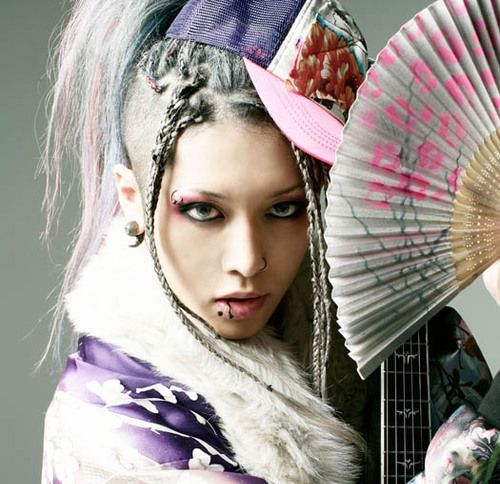 In a very different style than the rustic Finnish Forest Clan, I would to like to present the electrifying Japanese urbanite Ishihara Takamasa aka Miyavi. The above picture was my first encounter with this artist, and I wanted to share the experience with others. Born from a Zainichi Korean father and a Japanese mother in Osaka in 1981, he joined the visual kei band Dué le Quartz in 1999, before starting his solo guitarist career after the band’s dissolution in 2002. He has since then released seven studio albums: Gagaku (2002), Galyuu (2003), Miyavizm (2005), MYV Pops (2006), Miyaviuta -Dokusou- (2006), This Iz the Japanese Kabuki Rock (2008) and What’s My Name? (2010).
In a very different style than the rustic Finnish Forest Clan, I would to like to present the electrifying Japanese urbanite Ishihara Takamasa aka Miyavi. The above picture was my first encounter with this artist, and I wanted to share the experience with others. Born from a Zainichi Korean father and a Japanese mother in Osaka in 1981, he joined the visual kei band Dué le Quartz in 1999, before starting his solo guitarist career after the band’s dissolution in 2002. He has since then released seven studio albums: Gagaku (2002), Galyuu (2003), Miyavizm (2005), MYV Pops (2006), Miyaviuta -Dokusou- (2006), This Iz the Japanese Kabuki Rock (2008) and What’s My Name? (2010).
As a visual kei artist, Miyavi targets visual overload, be it through his osentatious costumes, experimental hairstyle or dizzying music videos. But this characteristic is only an accessory to his incredible, supersonic guitar play. The whole is blended as a uniquely Japanese sensory overload, inspired by early 1990s visual kei pioneers such as X-Japan (the term visual kei actually from X-Japan’s slogan of “psychedelic violence crime of visual shock”; see also their songs Desperate Angel and Weekend) and Kabuki Rocks (Kabuki being a style of traditional Japanese theater that often makes heavy use of heavy make-up and flamboyant costumes; you can get more of them by copying their Japanese name カブキロックス in youtube). You may judge by yourself how this comes out nowadays with young Japanese artists like Miyavi:
.If you are looking for some visual violence, I recommend Pop is Dead (the audio on this video needs to be turned up a bit), Joushou Gaidou or Neo Visualizm. If you want the audio side of Miyavi, some concentrated guitar awesomeness, have a look at Selfish Love, Are You Ready to Rock?, What’s my name?, Strong or Survive. Talking about surviving, I hope you ears will have done just that, after all these vids.
